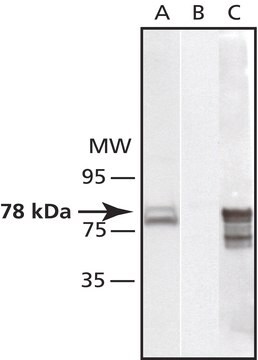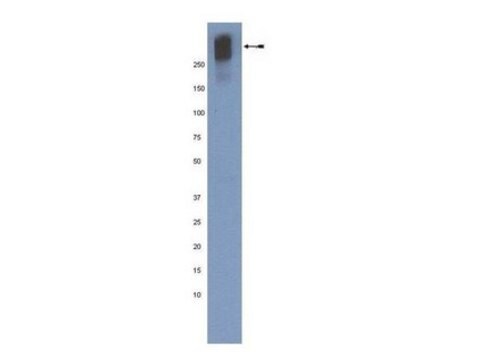AB3000
Anti-IP3-Rezeptor-Typ-II-Antikörper
Chemicon®, from rabbit
Synonym(e):
Inositol 1,4,5-Trisphosphate Receptor
About This Item
Empfohlene Produkte
Biologische Quelle
rabbit
Qualitätsniveau
Antikörperform
affinity isolated antibody
Antikörper-Produkttyp
primary antibodies
Klon
polyclonal
Aufgereinigt durch
affinity chromatography
Speziesreaktivität
mouse, hamster, human, monkey, rat
Hersteller/Markenname
Chemicon®
Methode(n)
immunocytochemistry: suitable
immunofluorescence: suitable
immunohistochemistry: suitable
immunoprecipitation (IP): suitable
western blot: suitable
NCBI-Hinterlegungsnummer
UniProt-Hinterlegungsnummer
Versandbedingung
wet ice
Posttranslationale Modifikation Target
unmodified
Angaben zum Gen
human ... ITPR2(3709)
Spezifität
Immunogen
Anwendung
Signalisierung
GPCR, cAMP/cGMP & Calcium-Signalisierung
Immunfluoreszenz: 1:10–1:20
Immunpräzipitation
Immunzytochemie: Ergibt bekanntermaßen eine positive Reaktivität mit den Zelllinien AR4-2J, HL-60, COS-I, HEK-293 und RBL-2H3.
Immunhistochemie: Paraformaldehyd- oder Methanol-Fixierungen sind effektiv.
Optimale Arbeitsverdünnungen müssen vom Endanwender bestimmt werden.
Physikalische Form
Lagerung und Haltbarkeit
Rechtliche Hinweise
Haftungsausschluss
Sie haben nicht das passende Produkt gefunden?
Probieren Sie unser Produkt-Auswahlhilfe. aus.
Lagerklassenschlüssel
10 - Combustible liquids
WGK
WGK 2
Analysenzertifikate (COA)
Suchen Sie nach Analysenzertifikate (COA), indem Sie die Lot-/Chargennummer des Produkts eingeben. Lot- und Chargennummern sind auf dem Produktetikett hinter den Wörtern ‘Lot’ oder ‘Batch’ (Lot oder Charge) zu finden.
Besitzen Sie dieses Produkt bereits?
In der Dokumentenbibliothek finden Sie die Dokumentation zu den Produkten, die Sie kürzlich erworben haben.
Unser Team von Wissenschaftlern verfügt über Erfahrung in allen Forschungsbereichen einschließlich Life Science, Materialwissenschaften, chemischer Synthese, Chromatographie, Analytik und vielen mehr..
Setzen Sie sich mit dem technischen Dienst in Verbindung.




